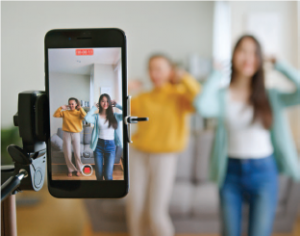The fuss over TikTok…and why you should care.

www.istockphoto.com
There are more than 8 billion humans on this planet and, if you believe what you read, more than a billion actively watch TikTok videos. If TikTok were an organized religion—and for many young people it kind of is—it would rank third behind Christianity and Islam, possibly tied with Hinduism. For the record, the population of TikTok accounts is growing faster than the population of Hindus.
If you’ve never watched TikTok or don’t understand what it is, don’t feel bad. Most people on TikTok don’t really know either. They’re too busy having fun.
The app itself, which began as a platform for short, hyper-expressive homemade videos—particularly amusing dance videos and pop songs—was created by a company called Musical.ly and purchased in 2017 by the Chinese company ByteDance for $800 million. It took off during the pandemic, especially among teens and twenty-somethings. Influencers moved en masse to the app from Facebook, Instagram and Twitter, and advertisers followed. In 2021, TikTok raked in more than $4 billion in advertising revenue. In 2022, that number more than doubled—at a time when ad revenue for digital competitors sagged. That has people like Mark Zuckerberg more than a little concerned; he has gone so far as to warn that TikTok’s growing dominance is a threat to the US tech sector.

www.istockphoto.com
TikTok content has evolved somewhat, but not a lot. It’s still silly and stupid and crazy and imaginative. There’s just a lot more selling than there used to be. Unlike other social media apps, where the inclusion of ads is fairly obvious, TikTok advertisements are often disguised as one of the endless short videos that flow across the small screen, one after another, based on algorithms keyed to a user’s interests. Often, you don’t know you’re watching a commercial until its mostly done. If it’s good, you don’t even care.
For many, TikTok has become addictive. The average user spends on average more than 90 minutes a day glued to the app. In this country, there are around 100 million active users. That is an impressive digital footprint. To some, it is a threatening one.
Joe Biden and Donald Trump don’t agree on much, but one thing they have in common is a deep distrust of TikTok. Both of their administrations tried to curtail its influence. They weren’t concerned with the deleterious effect on young minds. It was the Chinese-owned part of TikTok that raised all kinds of red flags (no pun intended). ByteDance has consistently assured our government that the data it collects on Americans stays in America, on American servers. Yet Chinese law is very clear that its government can demand data from US affiliates of Chinese companies. So which is it?
US officials have been pressuring ByteDance to change its ownership here so that the direct link to China is severed. The Biden administration considers it a national security issue. The US military has banned the app on personal devices, as has TSA and a handful of state governments, including Texas. Many politicians on both sides of the aisle would like to see the app banned altogether.
In late-December, the big omnibus spending bill passed in Congress included a new regulation that prohibited federal government employees from downloading the TikTok app on their mobile devices—and instructing those who already have it to delete it. Senator Marco Rubio introduced a bipartisan bill on December 13th banning TikTok in the US altogether.
There is another issue generating profound concern over the growth of TikTok and that is its ability to prevent underage users from accessing violent, hateful, drug-related or sexual content. Right now, the minimum age to open a TikTok account is 12. Raising the minimum age to 17 or 18 has been discussed but, naturally has met with all kinds of resistance from the company. There is now a consumer protection lawsuit in Indiana around this issue. The Attorney General claims that TikTok has deceived children and their parents with the age rating of 12, dishonestly leveraging consumer trust in app stores like Google’s and Apple’s.
In 2021, TikTok introduced a feature enabling parents to link their TikTok accounts with that of their children, which theoretically would enable moms and dads to monitor and control what their young teens are watching. And the app has special filters to identify, delete and punish offensive videos before they reach young eyes. Not surprisingly, there are myriad work-arounds for these safeguards, including the use of alternative words for ones that are likely to be caught in the algorithm, such as “unalive” for “kill” and “seggs” for “sex.” There is even a word for this new vocabulary: Algospeak.
The problem is that TikTok is fun and cool and easy to use. It is a brilliant cure for boredom and a break from reality. And in the way that Facebook used to say it was the new office water cooler, TikTok has become the younger, hipper version of that.
Anyone with a smartphone can make a TikTok video in a matter of minutes. People who go about their lives otherwise unnoticed can have hundreds or thousands of followers. An ad that might only get a few glances somewhere else can rack up millions of views and increase sales by 100 or 500 or 1,000 percent. TikTok is the most efficient way to attract, influence and capture young consumers, who eagerly share what they like and willingly tumble down the TikTok rabbit hole.
While TikTok’s supporters hail it as a new cultural and communications frontier, its critics have called it a Trojan Horse, a Wolf In Sheep’s Clothing and—especially resonant for those who recall the notorious R.J. Reynolds cigarette campaign of the early 1990s—Joe Camel on Steroids.





